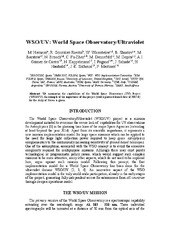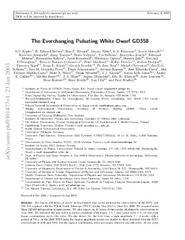Artikler, rapporter og annet (fysikk og teknologi): Recent submissions
Now showing items 1021-1040 of 1062
-
Understanding the Cool DA White Dwarf Pulsator, G29–38
(Journal article; Tidsskriftartikkel; Peer reviewed, 1997-10-10)The white dwarfs are promising laboratories for the study of cosmochronology and stellar evolution. Through observations of the pulsating white dwarfs, we can measure their internal structures and compositions, critical to understanding post main sequence evolution, along with their cooling rates, allowing us to calibrate their ages directly. The most important set of white dwarf variables to ... -
WSO/UV: World Space Observatory/Ultraviolet
(Journal article; Tidsskriftartikkel, 2002-11-05)We summarize the capabilities of the World Space Observatory (UV) Project (WSO/UV). An example of the importance of this project (with a planned launch date of 2007/8) for the study of Novae is given. -
The Everchanging Pulsating White Dwarf GD358
(Journal article; Tidsskriftartikkel; Peer reviewed, 2003-01-23)We report 323 hours of nearly uninterrupted time series photometric observations of the DBV star GD 358 acquired with the Whole Earth Telescope (WET) during May 23rd to June 8th, 2000. We acquired more than 232 000 independent measurements. We also report on 48 hours of time-series photometric observations in Aug 1996. We detected the non-radial g-modes consistent with degree ℓ = 1 and radial ... -
Multiwavelength observations revealing the outbursts of the two soft X-ray transients XTE J1859+226 and XTE J1118+480
(Conference object; Konferansebidrag, 2001-02-06)We report here on multiwavelength observations of the two new soft X-ray transients (SXTs) XTE J1859+226 and XTE J1118+480, which we observed with HST/RXTE/UKIRT. For XTE J1118+480 we also used EUVE since it is located at a very high galactic latitude and suffers from very low extinction. The two sources exhibited very different behaviour. XTE J1859+226 seems quite normal and therefore a good ... -
Evidence of low-dimensional chaos in magnetized plasma turbulence
(Working paper; Arbeidsnotat, 2008-03-10)We analyze probe data obtained from a toroidal magnetized plasma configuration suitable for studies of low-frequency gradient-driven instabilities. These instabilities give rise to field-aligned convection rolls analogous to Rayleigh-Benard cells in neutral fluids, and may theoretically develop similar routes to chaos. When using mean-field dimension analysis, we observe low dimensionality, but ... -
Modeling temporal fluctuations in avalanching system
(Working paper; Arbeidsnotat, 2008-07-22)We demonstrate how to model the toppling activity in avalanching systems by stochastic differential equations (SDEs). The theory is developed as a generalization of the classical mean field approach to sandpile dynamics by formulating it as a generalization of Itoh’s SDE. This equation contains a fractional Gaussian noise term representing the branching of an avalanche into small active clusters, ... -
A stochastic theory for temporal fluctuations in self-organized critical systems
(Working paper; Arbeidsnotat, 2008-07-22)A stochastic theory for the toppling activity in sandpile models is developed, based on a simple mean-field assumption about the toppling process. The theory describes the process as an anti-persistent Gaussian walk, where the diffusion coefficient is proportional to the activity. It is formulated as a generalization of the Itˆo stochastic differential equation with an anti-persistent fractional ... -
Scale-free vortex cascade emerging from random forcing in a strongly coupled system
(Working paper; Arbeidsnotat, 2008-03-04)The notions of self-organised criticality (SOC) and turbulence are traditionally considered to be applicable to disjoint classes of phenomena. Nevertheless, scale-free burst statistics is a feature shared by turbulent as well as self-organised critical dynamics. It has also been suggested that another shared feature is universal non-gaussian probability density functions (PDFs) of global fluctuations. ... -
E-pile model of self-organized criticality
(Working paper; Arbeidsnotat, 2007-11-28)The concept of percolation is combined with a self-consistent treatment of the interaction between the dynamics on a lattice and the external drive. Such a treatment can provide a mechanism by which the system evolves to criticality without fine tuning, thus offering a route to self-organized criticality (SOC) which in many cases is more natural than the weak random drive combined with ... -
Stretched-exponential decay functions from a self-consistent model of dielectric relaxation
(Working paper; Arbeidsnotat, 2007-07-22)There are many materials whose dielectric properties are described by a stretched exponential, the so-called Kohlrausch-Williams-Watts (KWW) relaxation function. Its physical origin and statistical-mechanical foundation have been a matter of debate in the literature. In this paper we suggest a model of dielectric relaxation, which naturally leads to a stretched exponential decay function. Some ... -
Stretched exponential relaxation and ac universality in disordered dielectrics
(Working paper; Arbeidsnotat, 2007-05-30)This paper is concerned with the connection between the properties of dielectric relaxation and ac (alternating-current) conduction in disordered dielectrics. The discussion is divided between the classical linear-response theory and a self-consistent dynamical modeling. The key issues are, stretched exponential character of dielectric relaxation, power-law power spectral density, and anomalous ... -
The pulsation modes of the pre-white dwarf PG 1159-035
(Journal article; Tidsskriftartikkel; Peer reviewed, 2008)Context. PG 1159-035, a pre-white dwarf with Teff ≃ 140 000 K, is the prototype of both two classes: the PG 1159 spectroscopic class and the DOV pulsating class. Previous studies of PG 1159-035 photometric data obtained with the Whole Earth Telescope (WET) showed a rich frequency spectrum allowing the identification of 122 pulsation modes. Analyzing the periods of pulsation, it is possible to ... -
Studies of DC biasing of internal ring on plasma rotation and transport in a toroidal geometry
(Conference object; Konferansebidrag, 2004-10)We report results from experiments performed to study how a DC bias with respect to the plasma potential is affecting the plasma states in the toroidal geometry of the Blaamann device in Tromso. In the experiments discussed here, a ring with smaller diameter than the limiter was centered inside the bulk of the plasma and its bias varied with respect to the plasma potential. In the electron ... -
The relationship between small-scale and large-scale ionospheric electron density irregularities generated by powerful HF electromagnetic waves at high latitudes
(Journal article; Peer reviewed; Tidsskriftartikkel, 2006-11-21)Satellite radio beacons were used in June 2001 to probe the ionosphere modified by a radio beam produced by the EISCAT high-power, high-frequency (HF) transmitter located near Tromsø (Norway). Amplitude scintillations and variations of the phase of 150- and 400-MHz signals from Russian navigational satellites passing over the modified region were observed at three receiver sites. In several papers ... -
Directional features of the downshifted peak observed in HF-induced stimulated electromagnetic emission spectra obtained using an interferometer.
(Journal article; Peer reviewed; Tidsskriftartikkel, 2006-08-09)A high frequency (HF) ionospheric modification experiment was carried out between 25 September and 8 October 2004, using the EISCAT HF transmitter located near Tromsø, Norway. During this experiment the spectra of the stimulated HF sideband waves (stimulated electromagnetic emission or SEE) induced by the HF pump were observed using an interferometer consisting of three spaced receiving antennas ... -
Plasma density over Svalbard during the ISBJØRN campaign.
(Journal article; Peer reviewed; Tidsskriftartikkel, 2000)In 1997, reliable operation of the EISCAT Svalbard Radar (ESR) was achieved and a rocket launching facility at Ny Ålesund on Svalbard (79°N, 12°E) (SVALRAK) was established. On 20 November, 1977, the first instrumented payload was launched from SVALRAK. Although the payload configuration had been flown many times previously from Andøya Rocket Range on the Norwegian mainland, this presented an ... -
Winter warmings, tides and planetary waves. Comparisions between CMAM (with interactive chemistry) and MFR-MetO observations and data.
(Journal article; Peer reviewed; Tidsskriftartikkel, 2006-10-20)Following earlier comparisons using the Canadian Middle Atmosphere Model (CMAM, without interactive chemistry), the dynamical characteristics of the model are assessed with interactive chemistry activated. Time-sequences of temperatures and winds at Tromsø (70° N) show that the model has more frequent and earlier stratospheric winter warmings than typically observed. Wavelets at mesospheric heights ... -
The effect of electron bite-outs on artificial electron heating and the PMSE overshoot.
(Journal article; Peer reviewed; Tidsskriftartikkel, 2005-12-23)We have considered the effect that a local reduction in the electron density (an electron bite-out), caused by electron absorption on to dust particles, can have on the artificial electron heating in the height region between 80 to 90 km, where noctilucent clouds (NLC) and the radar phenomenon PMSE (Polar Mesospheric Summer Echoes) are observed. With an electron density profile without ... -
Relative drift between black aurora and the ionospheric plasma.
(Journal article; Tidsskriftartikkel, 2005-07-27)Black auroras are recognized as spatially well-defined regions within uniform diffuse aurora where the optical emission is significantly reduced. Although a well studied phenomenon, there is no generally accepted theory for black auroras. One theory suggests that black regions are formed when energetic magnetospheric electrons no longer have access to the loss cone. If this blocking mechanism drifts ... -
The red-sky enigma over Svalbard in December 2002
(Journal article; Peer reviewed; Tidsskriftartikkel, 2005-07-27)On 6 December 2002, during winter darkness, an extraordinary event occurred in the sky, as viewed from Longyearbyen (78° N, 15° E), Svalbard, Norway. At 07:30 UT the southeast sky was surprisingly lit up in a deep red colour. The light increased in intensity and spread out across the sky, and at 10:00 UT the illumination was observed to reach the zenith. The event died out at about 12:30 UT. Spectral ...


 English
English norsk
norsk


















